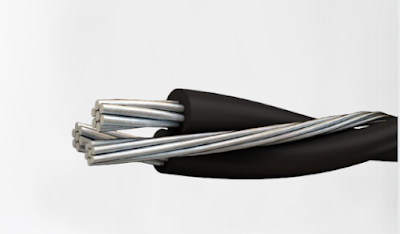Types of Cables Used in Mines
Mining cables and trailing cables that are used in mining and other heavy-duty industrial applications. While they have some similarities, they also have significant differences.
Mining cables are designed to withstand harsh environmental conditions such as low and high temperatures, moisture, and abrasion in underground and surface mining operations. They are commonly used to power heavy machinery and equipment like drills, loaders, conveyors, and pumps, but they can also be used for lighting and communication.
Trailing mining cables, on the other hand, are intended for use in mobile and flexible applications that require frequent bending, twisting, and movement. They are commonly used in industrial applications such as mining, crane and hoist systems, and transportation.
The conductor, dielectric, and sheath are the three main components of a power cable.
The conductor provides the current's conducting path in the cable. The insulation, also known as the dielectric, withstands the service voltage and isolates the live conductor from other objects. The sheath prevents moisture from entering and shields the cables from all external influences, such as chemical or electrochemical attacks and fire.
Types of mining cables
In mines, several different types of cables are used. There are fixed mining cables and portable mining cables, with the latter being the focus of this article.
Portable cables must be flexible as well as resistant to mechanical abrasion and damage. A special design may be required due to the additional demands placed on portable mining cables used for reeling and dereeling applications.
There are numerous kinds of portable mining cables. They are available in voltage ratings of up to 25 kV and can have up to five conductors.
The illustration depicts an example of a SHD-GC cable. It consists of three shielded insulated conductors, two bare ground wires, a ground check wire, and an overall jacket.
This cable's conductors are annealed, bare, or tinned copper wires. Tin-coated wires or a tin-coated copper wire/textile composite may be used in the braided shield.
Power cables
These are typically designed to handle high voltage and current levels in order to power heavy-duty mining equipment.
They are frequently made of copper or aluminum, with insulation and sheathing materials like rubber, PVC, or cross-linked polyethylene (XLPE).
Additional layers of shielding and armor may be added to some power cables to protect against physical damage and environmental factors such as moisture, heat, and chemicals.
Control cables are used to send low-voltage signals and control commands to mining equipment.
To reduce electrical interference, they may have multiple conductors and insulation materials such as PVC or polyethylene, as well as a metallic shield.
Some control cables may also have an additional jacket or armor layer for mechanical protection.
Communication cables
These are used to transmit high-speed data and voice signals throughout the mine, including control rooms, mining equipment, and personnel.
Because of their high bandwidth and resistance to electromagnetic interference, fiber-optic cables are commonly used for communication in mines.
They are typically made of multiple strands of glass fiber coated in protective materials such as polyethylene or nylon.
Hoist cables
These are typically made of high-strength steel wire that has been braided or twisted into a strong cable.
To reduce friction and wear during use, hoist cables may also have a lubricant coating or a layer of plastic.
They are usually made to be flexible enough to move with the hoist equipment and withstand heavy loads.
Pump cables
Pump cables are typically designed to be flexible and long-lasting, with PVC or rubber insulation and sheathing.
Pump cables may also have additional reinforcement layers to protect against mechanical damage and chemical exposure, as they are frequently used in submersible pumps that are exposed to water and chemicals.
Ventilation cables are typically made of PVC or polyethylene and have multiple conductors for power and control signals.
A metallic shield may be added to ventilation cables to reduce electromagnetic interference.
Mining cables are specialized cables that are used to power heavy machinery and equipment in mining operations. Here are some of the most common applications for mining cables:
Applications and uses of mining cable
• Mining cables are used to send power to underground and surface mining equipment such as drills, loaders, conveyors, and pumps.
• Mining cables are used to transmit data and communication signals throughout mining operations, allowing workers to communicate with one another as well as with equipment.
• Mining cables are used to power mine lighting systems, which are critical for worker safety and visibility in low-light conditions.
• Mining cables are used to transmit signals that control and automate mining equipment, enabling a more precise and efficient operation. Mining cables are built to be extremely safe.
Choose Right Australian Mining Cable Manufacturers and Suppliers
If you are confused about the selection of the mining cables, then we at Znergy Cable will help you in the process. We have a wide range of mining and trailing cable manufactured with premium quality material and hi-tech. We are the best Australian cable manufacturer in Australia.
Visit also:
https://znergycableaustralia.blogspot.com/2024/03/what-is-copper-armored-cable-current.html
https://znergycableaustralia.blogspot.com/2024/03/how-are-capillary-tubes-made.html
https://znergycableaustralia.blogspot.com/2024/03/what-is-4-0-triplex-underground-wire.html
https://znergycableaustralia.blogspot.com/2024/03/what-is-3-core-16mm-armoured-cable.html
https://znergycableaustralia.blogspot.com/2024/03/what-are-type-2s-cable-ties.html
https://znergycableaustralia.blogspot.com/2024/03/how-does-capillary-tube-work-in.html
https://znergycableaustralia.blogspot.com/2024/03/difference-between-mv-cable-and-hv-cable.html
https://znergycableaustralia.blogspot.com/2024/03/what-safety-features-does-type-409.html
https://znergycableaustralia.blogspot.com/2024/03/when-to-use-heat-resistant-cables.html
https://znergycableaustralia.blogspot.com/2024/02/type-450-cable-in-australia.html




Comments
Post a Comment